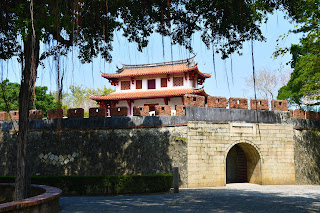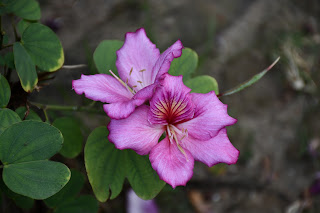Tainan
This
quarter’s examinations, for reasons unknown to me, fell on a Wednesday. The
reason this decision did not quite make sense to me is that the 28th
of February (the following Friday) is a bank holiday in Taiwan. Essentially,
the program expected us students to sit a day of class right after our finals until
consenting to release us from our misery.
I don’t
think I ever skipped class in college, but the dull regimen (and sometimes the
unreasonableness) of ICLP have broken my resistance to cutting corners every
now and then. At some point towards the beginning of the week, I made up my
mind not to go to school on Thursday, and, after checking the weather forecast,
started planning my long-desired trip to the south of Taiwan.
I left
Taipei a little later in the morning than I would have liked to, as I was
unable to find tickets at a reasonable time like six or six thirty. I arrived
in Tainan a little after ten, and the (free!) shuttle bus from the Tainan High
Speed Railway Station brought my arrival time in the city proper closer to ten
thirty or eleven. While sitting on the bus, I read my book so intently that I forgot
what the terminal station was, which made me afraid to follow through with my
original plan to simply disboard when it drew to a stop. Instead, I hopped off
as soon as we arrived at the first monument I recognised – the Koxinga Museum.
The Koxinga
Museum, which stands right next to the city’s Koxinga Shrine, houses a couple –
if not too many – quite interesting and valuable artefacts, among them the only
remaining exemplar of Koxinga’s own calligraphy. The second floor of the museum
exhibits the boards that used to be put above the entrance to the local Confucius
temples. Both the Museum and the Shrine seemed practically deserted, except for
a young woman apparently doing the part of the wedding photoshoot where you
ditch your fiancé and take glamour shots alone. Interestingly, the shrine
memorialises not just Koxinga, but also his mother, his grandson, and the
Prince of Ningjing.
The entrance to the Koxinga Shrine
A portrait of Koxinga
The last of Koxinga's handwriting
The second floor exhibition
An example of a sign put above the entrance of a Confucian temple
The inner courtyard of the Koxinga Shrine
Another view of the courtyard
The interior of the central shrine
A very lifelike idol modelled after the likeness of Koxinga
The memorial tablet of Koxinga's mother
Another view of the memorial tablet
The garden behind the Koxinga Shrine
From the
shrine, I crossed the street to the Lady Linshui Temple, apparently a temple
very popular with women, as its patron deities specialise in fertility and
protect both unborn children and pregnant mothers. From there, it was only a
short walk south to another three important sights: the Great South Gate, the
ruins of the former city wall, and the Five Concubines Temple. The Great South
Gate, at least in its present form, dates back to 1736, and is one of the few
remnants of the city’s original defences. The Five Concubines Temple claims an
even older origin, having begun in 1683 to memorialise five of the Prince of
Ninjing’s concubines, who committed suicide rather than submit to the Qing
invaders.
The interior of The Lady Linshui Temple
The Great South Gate
The Great South Gate behind the first fortification
The Great South Gate through the arch of the first wall
The old fortifications of Tainan
The Five Concubines Temple
Idols of the Five Concubines
Since the
Five Concubines Temple is at the southernmost end of the historically
interesting zone of Tainan, and I did not intend to return to the city centre
past the sights I had already seen, I hailed a cab and rode to the western part
of the city, known for hundreds of years as Anping. From a Western point of
view, Anping is perhaps the most interesting part of Tainan, and that for
several reasons. Firstly, when the Dutch arrived in Formosa in 1624, it was in
Anping that they built their first fort, named Fort Zeelandia after one of the
ships that had carried them there. Secondly, when Tainan was declared a treaty
port under the Treaty of Tianjin in 1858, it was in Anping that western trading
companies built their houses (the other treaty port established in Taiwan was
Tamsui. Keelung and Takao (Kaohsiung/Gaoxiong) were later opened up as well to
ease the strain on the former two).
How strange
to ride through streets built over the forests, fields, and marshes where the
Dutch once fought and converted Taiwan’s indigenous population, and the Chinese
waged war against the Dutch. Picturing in the city’s stead Taiwan’s once untamed
wilderness, through which the missionary Candidius trekked from Zeelandia to the
local village of Sinkan, seemed as difficult to me as imagining a primeval
scene with creatures transported through time from the Triassic.
I found the
Fort of Zeelandia in a remarkably well-kempt state. After falling to Koxinga,
it was renovated several times by the Chinese, making it a little difficult
sometimes to distinguish one layer of red brick from the next. I was pleasantly
surprised by the museum, which featured not only a painting on the famous motif
of Antonius Hambroek leaving Fort Zeelandia, but also a weathered copy of
Frederick Coyett’s Verwaerloosde Formosa (Neglected Formosa). Finding the latter made
me let out an audible gasp.
Fort Zeelandia
One of the many, many statues of Koxinga, this time at Fort Zeelandia
Qing Cannons at Fort Zeelandia
Another view of the same cannons
The trees were in bloom during my visit
Another bloom
The iconic scene of Hambroek taking leave of his grieving family
The ruins of the original Dutch fortifications
Topiary arts
Wild vegetation sprouting from the remains of the original Dutch fortifications
A view of the fort from the museum building
The same view but landscape
A copy of Verwaerloosde Formosa
Besides visiting
Fort Zeelandia, I also stopped by the Julius Mannich and the Tait & Company
old merchant houses. The latter happened to be open, with a relatively
interesting exhibition. Walking back past the fort, I made a stop by the Kaitai
Tianhou Temple, established in 1668 and boasting a Mazu deity brought over from
the mainland by Koxinga himself. Unfortunately, I was not able to tell which of
the many, many wooden statues it was.
The Old Julius Mannich House
The statues of two women who both suffered a Madam Butterfly-esque fate
The balcony of the Old Tait and Company House
The Kaitai Tianhou Temple
A closer view of the Kaitai Tianhou Temple
An idol at the Kaitai Tianhou Temple
Another idol
More idols at the Kaitai Tianhou Temple
The same idols behind their offerings
Once that
was done, I let myself be lured into a car by a taxi driver and made my way
back to the centre of the city. I had thought about getting lunch, but my
hunger left me at some point during the car ride, which freed me up considerably.
I weaved my way through the Five Canals Cultural Zone with its multitude of
temples, taking in the religious atmosphere of old Tainan. I was slowly but
surely becoming a little Temple-tired, so happening upon Chihkan Tower provided
me with a welcome respite. The tower actually stands on top of the second fort
the Dutch built in Tainan, named Fort Provintia. In the renowned work Formosa
under the Dutch, William Campbell notes how part of the fort was knocked
down during his very own lifetime, in order to make space for a Mazu temple,
which is why little but the foundations remains of the original structure. I
don’t think the Dutch would have considered this a particularly grieving loss,
since Fort Provintia fell to Koxinga after only a few days, unlike Zeelandia
which held out for nine months.
A dragon-like creature on the roof of the Water Fairy Temple
A gate leading to the Five Canals Cultural Zone
Temple roof decorations
A wonderfully preserved old model
An idol at one of the countless temples
A dragon pillar
Another pillar at the Kaiji Tianhou Temple
The altar at the Kaiji Tianhou Temple
Mazu deity at the Kaiji Tianhou Temple
Another idol
Another idol
Another idol
The goddess Mazu at the Kaiji Tianhou Temple
Another view of Mazu
Yet another view - I could not decide which picture is the best
By then, it
was late enough in the afternoon for me to check in at my hotel, which was
conveniently close to both the centre of the city and the train station. After
jettisoning essentially everything but my camera, wallet, and passport (and
eating all of the cookies in my room), I set off again, since there were still
a few sights towards the centre and east of the city which I had not yet seen.
These included the old Tainan weather station, as well as Maxwell Memorial
Church, built in honour of the first Presbyterian missionary to Taiwan. Of
course, several more temples in the vicinity were a must-see, especially the
oldest Confucius Temple in Taiwan, whose inner court was unfortunately
undergoing reconstruction. Nevertheless, one of the side rooms was open, and I
found, to my astonishment and self-satisfaction, that I recognised the writing
on the wall from my Classical Chinese class – it was an excerpt from “The Great
Learning.”
Maxwell Memorial Church
An alleyway behind the Zhengs' ancestral shrine
The interior of the Zhengs' ancestral shrine
Yet another statue of Koxinga
The Old Tainan Martial Arts Academy
The Tainan Confucius Temple
The front of the Confucius Temple
Another view of the Confucius Temple
A monument in the garden of the Confucius Temple
A room at the Confucius Temple
A tower in the garden of the Confucius Temple
The Tainan City Art Museum
An embossment at the entrance to the City God Temple
A sign at the City God Temple
A painted door at the City God Temple
The interior of the City God Temple
The last
few items on my itinerary comprised Christian historical sights. As a treaty
city and the former capital of Taiwan, Tainan naturally has many of these.
Besides the Maxwell Memorial Church, they also include the Taiwan Church Press (the
first printing office in Taiwan and publisher of Church News, the island’s
oldest newspaper), Barclay Memorial Church (dedicated to, incidentally, the
founder of the said newspaper), and the Catholic Cathedral ‘Our Lady Queen of
China’ – the first cathedral I have seen to be built in Chinese architectural
style. After eating dinner, I strolled back to my hotel, taking in the
atmosphere of Tainan’s sights in an evening glow.
An art installation outside the Taiwan Church Press
Barclay Memorial Church
A mural at the back of the Tainan Cathedral
The Tainan Cathedral behind a crowd of people watching Chinese opera
A blooming tree
A statue of Koxinga, this time on a horse, which I suspect would not have been entirely useful during the siege of Fort Zeelandia
Pavilion at the Confucius Temple
A stone gate
The National Museum of Taiwanese Literature
The corner of the National Museum of Taiwanese Literature
The National Museum of Taiwanese Literature from the front
Maxwell Memorial Church at night























































































Comments
Post a Comment